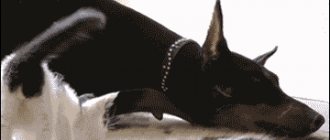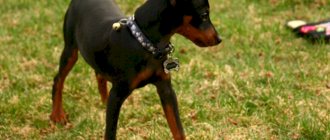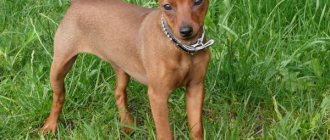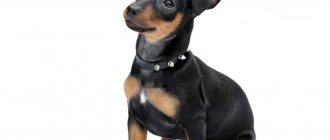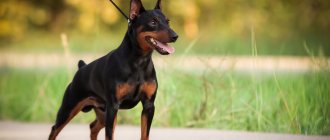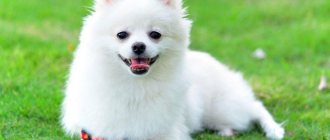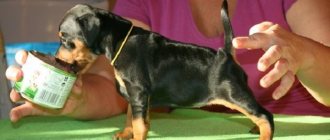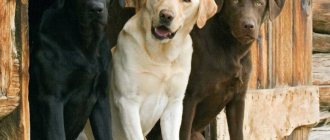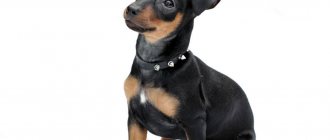Charming miniatures are the smallest representatives of pinschers, who have won love in all corners of the world. Initially, these dogs were used as skilled rat catchers in stables, and only by the 20th century were they made companion dogs.
Before purchasing a pet, it is important to familiarize yourself with the key features of miniature pinschers, existing varieties of the breed, rules of care and maintenance.
Brief history of the origin of the breed
The first written mention of miniature pinscher dogs dates back to the 15th century. It is believed that the miniature pinscher owes its appearance to its larger counterparts from Germany: dachshunds and Italian Greyhounds.
At the beginning of the 19th century, a standard pinscher could reach 50 cm at the withers, and its miniature copy - 40 cm. The modern dimensions, fixed by the standard, were obtained through painstaking selection and are no more than 30 cm.
The FCI established the description of the breed in international standards in the 55th year of the 19th century, placing medium- and dwarf-sized dogs in the “pinschers and schnauzers” section.
On a note. Abbreviating the name of the breed to Zwinger is erroneous, since such a search on the Internet, instead of a description of the Pinscher, only gives the history of the architectural complex in Dresden. The correct abbreviation is the German word “zwerg”, that is, “dwarf”.
Varieties
In total, there are 5 breeds bred on the basis of the Pinscher, each of which should be discussed separately:
- Miniature Pinscher - the smallest of all Pinschers. He has strong limbs, a powerful body with well-developed muscles. The fur is short, its color (according to the standard) can be red or black. According to the standard, these miniature dogs must have their ears and tail docked.
- Doberman is a pet of average height, its height at the withers usually does not exceed 0.5 m. This breed was developed by Friedrich Doberman (that is why this breed was named in his honor). These dogs are service dogs, they have a well-developed sense of smell, they are hardy, intelligent and at the same time very elegant. They are considered quite aggressive.
- German pinscher - a dog with an athletic build. His ears are high and erect, his muzzle is elongated. These dogs are smooth-haired; according to the standard, the color can be black or red.
- Australian Pinscher - A herding dog in the past, Australian farmers used these pinschers to help guard herds of sheep, as well as to catch rats and other small rodents. The fur is long and can have different colors.
- Affenpinscher – miniature pinschers, similar to primates (hence the name of the breed). The main feature of his appearance is his fluffy beard. These pinschers have floppy ears and very expressive eyes.
Description and characteristics of the breed
The Miniature Pinscher looks like a miniature Doberman Pinscher, but is an older breed. According to the international standard, miniature pinschers have the following parameters:
- high-set, erect or semi-erect triangular ears;
- elongated muzzle and black nose;
- black or brown almond-shaped eyes;
- powerful jaws with a scissor bite;
- graceful but strong neck without dewlap with a smooth transition to the withers;
- compact and fit body of a square shape with a wide chest and sloping back;
- powerful hind limbs, which are longer than the forelimbs;
- high-set tail (if desired, the owner docks it within 1.5–2 cm).
The dimensions of an adult miniature pinscher are determined by the gender of the dog:
- Female. The weight of an adult dog is 3.5–4 kg, and its height is 25–28 cm.
- Male. The size of an adult dog exceeds that of a female miniature pinscher and can reach 5 kg in weight and 30 cm in height.
Important. Miniature Pinscher size exceeding 30 cm may result in disqualification from the show.
The Miniature Pinscher has a short, hard coat with shiny guard hairs and no undercoat.
The Curly Pinscher is the result of crossbreeding with other breeds. Such dogs are considered a waste.
The standard allows 2 color options:
- deer with varying shades of brown;
- black and tan with dark tan markings at the base of the tail, on the chest, above the eyes, on the inner thigh, lower neck, base of the paws and wrists.
Types of Pinschers
Existing varieties of pinschers, which are close relatives of the miniature:
- German miniature pinscher. The dimensions of this pinscher exceed the size of a dwarf pinscher by 15 cm and reach 47 cm at the withers and 17 kg of weight.
- Doberman. This breed appeared thanks to breeding work with the German miniature pinscher.
- Austrian Smooth-haired Pinscher. Bred as a herding breed.
- The Affenpinscher is a black pocket pinscher. This is the only Curly Pinscher recognized by the FCI. Other pinscher breeds, including miniatures, must be smooth-haired.
The miniatures themselves are divided by color and place of birth. When breeding, each country determines which traits will predominate in the appearance or character of the breed:
- USA. The American Pinscher has a more pronounced relief and gracefulness.
- Israel. The main difference between this miniature pinscher and the classic miniature pinscher is its maximum similarity to the Doberman pinscher and its trot gait.
- Scandinavia. Pinscher with royal sophistication and balanced character.
- Germany. A standard smooth-haired miniature pinscher with a stocky build.
On the Internet there are advertisements for the sale of Japanese Pinscher. In fact, this breed of dog does not exist.
Regardless of the place of breeding, the color must strictly comply with the standard.
Acceptable:
- chocolate pinscher;
- ginger;
- brown miniature pinscher;
- black.
On a note. A white pinscher or a curly pinscher is considered a reject. If you buy a chocolate-colored miniature pinscher, the chocolate color should evenly cover its entire body. Interspersed with other colors are not allowed.
Miniature Pinscher and children
The Miniature Pinscher has a brave and easy-going character with a slight hint of extravagance. Unwanted behavior can be tamed in early childhood through training.
The active dog loves outdoor games, so the pinscher and children quickly become best friends. Children will quickly gain the trust of the miniature pinscher if they treat him with care.
The Miniature Pinscher is not easily frightened, so it attacks larger opponents without hesitation.
Price
The specific price factor depends on the influence of many other factors. This may concern the location of the animal, its age, and its coloring characteristics.
If you want to purchase a puppy from a verified owner along with the relevant documents, then you should expect a high price. In particular, experts call the figure $800-1000 for a puppy with RKF documentation, $400-500 is the price for a puppy with documents from SKOR.
How to choose the right puppy
Before choosing a puppy, you should make sure you have:
- comfortable and safe sleeping place;
- bowls for food and water;
- diapers and tray;
- veterinary clinics within walking distance.
When buying a miniature pinscher puppy, you need to pay attention to:
- Age. At 1 month, the puppy should be fed mother's milk. Early weaning from the mother is fraught with a decline in immunity.
- Compliance with standard. A curly pinscher at the price of a miniature is a direct fraud on the part of the breeder.
- General state. Miniature Pinscher puppies begin to be sold at 2 months. They should not have bald spots, a disheveled appearance, an incorrect bite or bad breath.
TOP nicknames
When choosing a name for a miniature pinscher, it is necessary to take into account euphony and ease of perception. Everything else is determined only by imagination.
Nicknames for girls miniature pinscher can emphasize:
- color – Squirrel, Shadow, Foxy;
- character – Candy, Speedy, Strelka.
The boy can be named according to a similar scheme:
- color – Black, Brown, Dark;
- character – Sloley, Shai, Wayne.
When choosing what to name a boy or girl Pinscher, you can choose the names of celebrities or favorite characters. An unusual nickname can always be upgraded into a simpler version, so don’t hold back your imagination.
You can call a Pinscher girl Beatrice, but in the family circle the name can be shortened to Tris.
Training
Training a miniature pinscher is mainly aimed at controlling leadership aspirations. It is recommended to start training at 3-4 months, when the puppy’s nervous system has already formed and he is ready to understand the requirements and follow commands.
The training is based on the dogs' natural inclinations. Training should develop useful skills in the dog and minimize individual character flaws. The desire to assert leadership and aggressiveness with age can turn a dog into an evil creature that brings nothing but trouble.
Firmness in training is required, but the miniature pinscher should be treated with patience, introducing punishment only in extreme cases. The trainer must remember the proud, touchy nature of the dog. Rudeness and pity are equally unacceptable in raising a dog. He is very smart, and indulging his whims will quickly develop into manipulation.
But in general, the miniature pinscher responds well to training, and with the right approach, an active, playful puppy will grow into an intelligent, loyal, balanced companion.
Miniature Pinscher Care
Miniatures do not require complex care, so representatives of this breed are excellent for keeping in an apartment.
Important. Due to the lack of undercoat, the miniature needs to purchase clothes. Warm overalls with a hood and boots will protect your miniature pinscher from hypothermia and reagents.
Miniature Pinscher care includes:
- Combing with a soft brush 2 times a month.
- Daily walks. The miniature pinscher is prone to obesity, so you should walk the dog 2 times a day to stay in shape.
- Bathing (no more than 1-2 times a year). For a small pinscher, it is enough to wash his paws after a walk and wipe his fur with a damp sponge.
- Regular inspection and cleaning of ears and nails. It is necessary to care for the miniature pinscher's ears with a light massage.
A special technique will allow you to maintain the correct shape of the auricle:
- Wrap two fingers around the base of your ear.
- Gently massage the ear cartilage and move towards the tip.
- As you move, pull the eyelet up.
To avoid fights with other animals, you should keep your miniature dog on a leash in crowded and noisy places.
What to feed your miniature pinscher
An adult miniature pinscher needs to be fed twice a day at the same time. The diet of miniatures can be:
- Dry. Dry food for a miniature pinscher should be super-premium or holistic class. Preference should be given to brands designed for small breeds.
- Natural.
The natural diet of a miniature pinscher includes:
- animal protein (beef, horse meat, sea fish, eggs);
- cereals (buckwheat, oatmeal, millet);
- vegetables (carrots, pumpkin, beets, zucchini) and fruits (rarely in the form of delicacies);
- fermented milk products (kefir, yogurt).
On a note. Include rye crackers in your miniature pinscher's food to prevent the development of tartar.
How to train a miniature pinscher
It is necessary to raise a miniature pinscher puppy from the first days of his appearance in the house.
Raising a miniature pinscher includes the following features:
- No concessions. When training a miniature pinscher at home, it is important to follow the established rules. Do not make concessions for a small puppy with a place on the bed, otherwise an adult dog will live there forever.
- Strengthening authority. Raising a miniature pinscher will not work without respect for the owners. The tsverg must understand that a man is more important than a dog.
- No violence. Pinschers are proud animals, so physical punishment should not be used on dogs of this breed.
Miniatures are smart dogs with high intelligence, so they can be trained from 3-4 months.
If training a miniature pinscher at home causes difficulties, then it is recommended to train your pet in a kennel club. In Moscow and other large cities, specialists conduct training not only in general groups, but also individually.
How to toilet train a miniature pinscher?
In order to accustom your Pinscher to the toilet at home, you need:
- Buy several trays and place them in place of the diapers.
- For the first time, it is worth putting the miniature pinscher in a tray so that the miniature pinscher understands the meaning of the new place.
- Having noticed anxiety on the part of the puppy, the owner needs to put the animal in the tray, wait for it to relieve itself and be sure to praise it.
Important. A dog of this breed should not be punished. A frightened puppy will not understand the message and will decide that it is better to avoid the litter box.
It is better to train a miniature pinscher to use the toilet outside from 6 months after vaccination.
Dogs quickly adopt the behavior of their relatives, so learning occurs by observing the actions of other animals.
The owner should be patient and not forget to praise if the pet is successful.
Ear and tail docking
It is not necessary to dock the Pinscher's tail and ears. The standard allows for both appearance options, so a pet without docking has every right to a show career. But the curly-haired pinscher does not meet the standard, and access to participation in exhibitions is denied to him.
The breed has its tail docked when the Miniature Pinscher is less than 1 week old. Ears are cropped later, but not later than the beginning of the change of baby teeth.
How to put ears on a miniature pinscher
The method of ear placement depends on the presence of cupping:
- Undocked. A dog with original ears may suffer from creases or too high set. Depending on the situation, the ears are fixed with tape or special glue in the desired position.
- Docked. In order to install ears on a docked miniature pinscher, you need to purchase tools for the frame on which the ears are placed: cotton swabs, a degreasing solution, a wide plaster.
Step-by-step instruction:
- Cut a piece of tape equal to the length of a cotton swab and degrease it with a solution.
- Attach it with a stick and cover with another piece of tape, sticky side up.
- Secure the structure in the ear by wrapping its base with tape in the shape of a figure eight.
- Remove the frame every 3 days and install again after a daily break. The ears will stand up in 2-3 weeks.
Caring for puppies
At 1 month, the miniature pinscher should be fed with special infant formula. From the age of 2 months, the Pinscher puppy begins to be fed calcined foods. Gradually, other permitted foods should be introduced into his diet, paying attention to the reaction from the pet’s body.
If the owner decides to feed a miniature pinscher puppy with dry food, it is recommended to give preference to the line for dogs up to 1 year old.
Character
Among the distinctive features of this breed is intelligence. Such animals are easy to raise, train, and follow all commands.
They are active animals, but at the same time reserved. In the family they show a playful character. But they treat strangers with distrust.
This quality helps the animal fulfill the role of a protector in the family who will protect your life. If the owner devotes little time to educational procedures, then the pinscher becomes practically uncontrollable.
According to statistics, this dog breed can be classified as a long-living dog. If you follow the basic rules of animal care, your pet can live up to 12-16 years of age.
It is also worth noting that due to the animal’s high intelligence, such pets are often stubborn. To minimize these manifestations, it is necessary to pay due attention to care and care.
With proper upbringing, the animal will be cheerful and cheerful. The Miniature Pinscher is an excellent friend for small children; it will never harm children. They perceive other pets normally if they are familiar with them in infancy. Otherwise, they treat them with hostility.
The animal is known for the following positive qualities:
- high-quality implementation of the security guard's functional features. By its nature, this breed of animal is suspicious. Therefore, if the pinscher notices that something is wrong, he immediately becomes wary;
- animals are able to give cats a head start, because they are famous for their distinctive ability to catch rats, moles, and mice.
When raising a pet, it is necessary to consciously begin this process from the first day. After all, in the first days of living with you, the animal will gradually understand what can be done and what is unacceptable.
It is worth remembering that representatives of this breed are characterized by excessive activity throughout their lives. You should not expect this situation to change as they grow older.
Vaccinations and susceptibility to disease
The procedure for vaccinating Miniature Pinscher puppies is no different from the vaccinations recommended for other breeds. The first vaccination for a miniature pinscher is given no earlier than 2 months, until the puppy is weaned from its mother; this procedure is not necessary.
Miniatures often suffer from the following diseases:
- diabetes;
- dysplasia and other bone tissue pathologies leading to lameness;
- cataracts, glaucoma and retinal atrophy;
- epilepsy;
- ICD;
- hypothyroidism
What age should you choose a dog?
It is preferable to purchase a dog when it is still a puppy.
The optimal age for a puppy is 2-3 months. During this period, miniature pinschers show curiosity and become independent. Their psyche is already established, so moving will no longer be too stressful for them. Adopting an adult dog is always worse than adopting a puppy. After all, she is already attached to her former owner, her character is already fully formed. For an adult Pinscher, moving will be very stressful. Before buying an adult dog, get to know it in advance, study its character and habits. It is very good if she is trained. Find out if the animal gets along with other pets, if you have any. How to prepare for the arrival of a puppy? Before you bring the puppy into the house, you need to: Set up a sleeping place for the dog; Determine the place where you will feed her; Learn more about how to care for your puppy; Decide on a veterinary clinic where you will go to get preventive vaccinations and periodically check your pet’s health. You need to decide on the toilet in advance. You can teach your four-legged friend to ask to go outside, but for such small breeds, a home toilet is quite acceptable, the location of which should be determined in advance.
Source
How long do miniature pinschers live?
The lifespan of a miniature pinscher is determined by the maintenance, care and individual characteristics of the dog. On average, miniatures live about 13 years.
Important! Maximum miniature pinschers live up to 15 years. Most of the factors influencing life expectancy depend on the owner. With proper care, your pet will live longer than average.
When purchasing a miniature pinscher, it is important to realize: how long the pet will live largely depends on the owner.
Photo gallery
Perhaps, after viewing a selection of photos of these miniature creatures with a strong character, you will decide to get yourself a similar pet.
Summary: pros and cons of the breed
Like all dog breeds, miniature pinschers have their positive and negative sides.
| Advantages | Flaws |
| Miniature size, which allows you to keep a dog even in a small apartment | Low frost resistance |
| Good security qualities | The need for regular physical activity |
| Scanty shedding | Dominant character that interferes with training and communication with other animals |
| High learning ability and developed intelligence | Tendency to damage shoes and furniture |
| Love for children | Jealous character |
| Endurance and unpretentiousness in food |
The Miniature Pinscher is an active and unpretentious pet for large families with small children, people with an active lifestyle and other owners who are ready to accept the shortcomings of the breed.
Due to the acute need for daily physical activity, the dog is not suitable for workaholics, retirees and people with disabilities.
If you approach the choice of a future four-legged family member and care for him with all responsibility, the pet will repay you with gratitude and become an excellent guard and devoted friend.
Possible diseases
The Miniature Pinscher dog rarely gets sick and is in good health most of the time. Congenital defects are practically never found. But over the course of their lives, dogs can repeatedly damage their musculoskeletal system. The animal is active and crafty, which is why broken paws, cuts, and dislocations often occur.
Glaucoma, cataracts and entropion of the eyelids often occur among ophthalmological diseases. The animal may also suffer from pannus, a chronic disease of the cornea. It is impossible to cure the disease 100%, but it is possible to slow down the progression of the disease.
If a dog is overfed, problems with the gastrointestinal tract are possible - gastritis, colitis, as well as constipation and even bladder stones due to the abundance of pickles and sausages. From time to time the dog is susceptible to colds. Therefore, in cold weather, it is worth purchasing a special jacket with insulation for him. The simplest acute respiratory viral infections and acute respiratory infections can be complicated by bronchitis, tracheitis, and sometimes pneumonia.
Feeding
You can use high-quality ready-made diets, which should be given in accordance with the instructions indicated on the package. For a puppy, dry food is pre-soaked. A natural diet for adults should contain meat (beef, veal, offal) - at least 1/3 of the menu. The by-products are pre-boiled, the meat is given raw, defrosted. Bones are allowed, but only large (sugar) bones, raw - no more than 1 ruble per week.
A third of the diet should include porridge (millet, oatmeal, buckwheat), and the other third should include vegetables (fresh, stewed). You can make salads with the addition of vegetable oil and sour cream. It is necessary to give eggs (1-2 times/week), vitamin and mineral supplements. Diet composition for puppies:
- Protein foods (beef, chicken, dairy products) - 2/3 parts. This also includes sea fish and egg yolk, which give 1-2 rubles/week.
- Vegetables, grains – 1/3 part.
It is useful to give 1 clove of garlic per day (to prevent helminthic infestation). In addition, you need multivitamins. The Miniature Pinscher is prohibited from:
- food with added salt;
- products containing preservatives, sweeteners, chemical additives;
- salo;
- pork;
- legumes;
- sweets;
- raw fish;
- caffeinated products;
- tubular and fish bones.
You cannot overfeed, these dogs are prone to obesity. Feeding scheme:
- 1 month – 6 times/day;
- 2-3 months - 5 times;
- 3-4 months – 4 times;
- 4-6 months – 3 times;
- 6-12 months – 2 times/day.
Historical reference
Country of origin: Germany. The ancestors of pinschers lived in Central Europe already during the early Middle Ages. The main task of the dogs was to destroy rodents. Subsequently, pinschers became pets, valued for their intelligence and unpretentiousness.
Purposeful breeding of the breed began in the 2nd half of the 19th century. The official standard was approved in 1880; miniature pinschers were first exhibited in 1900. In Europe, they were very popular at the beginning of the 20th century, and it was at this time that ears and tails began to be cropped. Black, red and brown colors were considered fashionable. In the USA, the miniature pinscher club was founded in the 20s of the 20th century; representatives of the breed were brought to England in 1950.
Miniature pinschers came to Russia long before the revolution. After 1917, the number of animals decreased sharply. Interest in the breed arose after the Great Patriotic War; pinschers were brought from Germany and became popular among the Moscow intelligentsia. A new round of development occurred in the early 90s. Currently, the number of livestock in the country is increasing every year. Thanks to successful breeding work, dogs from Russia have a high breed level, which is recognized throughout the world.
